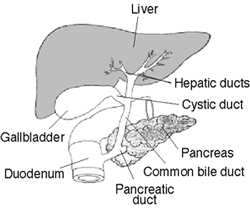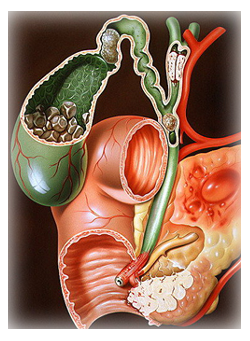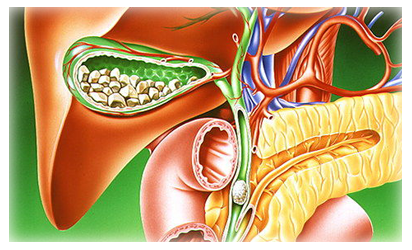What is a laparoscopic cholecystectomy?
Laparoscopic cholecystectomy is a surgical procedure in which
the doctor removes your gallbladder with the aid of a laparoscope.
The gall bladder is a small pear-shaped organ on the underside
of the liver that is used to store bile.A laparoscope is a small
telescope, which is attached to a small camera and light source
to enable the internal abdominal cavity to be visualized on
a television screen. Three or four small (less than a cm each)
incisions are made into the abdomen, through which the telescope
and laparoscopic instruments are inserted. Gas is passed into
the abdominal cavity to inflate it, so that the gallbladder
can be seen more easily.
Laparoscopic (Keyhole) cholecystectomy is the most common way
to remove the gallbladder today, but you should always keep
in mind that cholecystectomy may not always be possible laparoscopically
anda larger incision maybe needed to remove the gallbladder
(open cholecystectomy technique).On the other hand, it is now
also possible to perform cholecystectomy with a single small
incision at the umbilicus (belly button). This new technique
is known as SILS (single incision laparoscopic
surgery). SILS cholecystectomy gives superior cosmetic results
compared to even traditional laparoscopic cholecystectomy. You
can ask us if you are a candidate for SILS cholecystectomy.
 What
does the gallbladder do? What
does the gallbladder do?
The liver produces a substance called bile. This is a green
coloured liquid that helps the body to digest fats. Bile contains
water, cholesterol, fats, bile salts and bilirubin. Bile salts
break up the fat, and bilirubin gives stools their yellow-brown
color. The liver secretes bile into a branching network of small
tubes called bile ducts, which join together to form a single
large tube called common bile duct. The common bile duct opens
into the duodenum, which is the initial part of the intestine
just beyond the stomach. The gallbladder is connected to the
common bile duct. Thus the bile flows from the liver to the
common bile duct and into the gallbladder where it is temporarily
stored when we are fasting. After we take a meal, the gallbladder
contracts and emptiesbile into the duodenum where it helps to
break down the fats.
What are gallstones?
 Gallstones are formed when the bile stored in the gallbladder
hardens into pieces of stone-like material. Gallstones are mainly
composed of cholesterol. Most patients with gallstones remain
symptom-free for many years and may, in fact, never develop
any symptoms. Symptoms of gallstones are variable ranging from
brief episodes of abdominal pain (known as biliary colic) to
potentially life-threatening complications, such as acute inflammation
and infection of the gallbladder (cholecystitis), inflammation
of pancreas (pancreatitis) and obstructive jaundice.
Gallstones are formed when the bile stored in the gallbladder
hardens into pieces of stone-like material. Gallstones are mainly
composed of cholesterol. Most patients with gallstones remain
symptom-free for many years and may, in fact, never develop
any symptoms. Symptoms of gallstones are variable ranging from
brief episodes of abdominal pain (known as biliary colic) to
potentially life-threatening complications, such as acute inflammation
and infection of the gallbladder (cholecystitis), inflammation
of pancreas (pancreatitis) and obstructive jaundice.
It is accepted that the best treatment for gallstones that cause
symptoms is the removal of the gallbladder by keyhole surgery
(laparoscopic cholecystectomy). Occasionally surgery maybe recommended
for patients with gallstones in the absence of symptoms also.
When is a laparoscopic cholecystectomy
done?
This procedure is performed when you have stones or inflammation
in your gallbladder, causing pain. The gallbladder is shaped
like a pear. It is attached to the undersurface of the liver.
Bile produced in the liver is stored in the gallbladder. Concentrated
and stagnant bile can form sediment in the gallbladder that
can turn into gallstones. These stones may remain loose in
your gallbladder or they may block the gallbladder outlet
causing pain when the gallbladder contracts. In that case,
the gallbladder may also become swollen, inflamed, and/or
start (rarely) to decompose (become "gangrenous").
There are no alternatives to surgically removing the gallbladder
when it is causing pain.
Complications of Gallstones
Gallstones that are confined to the gallbladder usually only
cause intermittent episodes of pain, known as biliary colic.
When a stone blocks the exit of the gallbladder the flow of
bile is occluded, which can cause infection and inflammation
of the gallbladder, called acute cholecystitis. A patient
with acute cholecystitis may have a fever, severe upper right-sided
abdominal pain and may vomit.
When gallstones enter the common bile duct they can cause
jaundice, cholangitis and pancreatitis.
 The
stone blocking the flow of bile into the intestine causes
jaundice. This leads to absorption of bilirubin into the bloodstream
– causing yellow pigmentation of the skin and eyes.
This absorbed bilirubin is excreted in the urine and gives
it a dark yellow color. The
stone blocking the flow of bile into the intestine causes
jaundice. This leads to absorption of bilirubin into the bloodstream
– causing yellow pigmentation of the skin and eyes.
This absorbed bilirubin is excreted in the urine and gives
it a dark yellow color.
The obstruction of the common bile duct by a stone can also
lead to infection in the biliary system. This is known as
cholangitis. This infection can reach the liver if not treated
promptly, and can result in inflammation of the liver and
eventually liver abscesses.
Pancreatitis occurs when a gallstone passing through the bile
duct occludes the pancreatic duct leading to inflammation
of the pancreas. The pancreatitis usually resolves if the
gallstone passes out spontaneously into the duodenum. However,
about 10 percent of patients with pancreatitis develop severe
complications.
Presence of gallstones in the common bile duct can be confirmed
by doing an MRI of the abdomen known as MRCP (magnetic resonance
cholangio-pancreatography) Common bile duct stones have to
be removed in addition to removal of the gallbladder. These
can be removed by an endoscopy performed by inserting a flexible
tube through your month into your duodenum where the common
bile duct opens followed by removal of gallstones in the common
bile duct. This is known as endoscopic retrograde cholangio-pancreatography
(ERCP). ERCP
is usually done prior to laparoscopic cholecystectomy. Occasionally
it can be needed after the surgery if there is a stone detected
in the common bile duct later. It is also possible to remove
stones in the common bile duct surgicallyduring the laparoscopy
procedure. This is known as laparoscopic common bile duct
exploration. It is usually done for large stones in the common
bile duct or when ERCP fails to remove stones
Rare complications of gallstones include perforation of the
gallbladder, erosion of the gallbladder into the bowel (cholecysto-enteral
fistula) and passage of a gallstone into the bowel leading
to a bowel obstruction.
Occasionally due to certain difficulties encountered during
laparoscopic cholecystectomy, the surgeon may prefer to convert
to open cholecystectomy. The inflamed gallbladder is sometimes
stuck to surrounding organs or there may be excessive bleeding
during the surgery and therefore the surgeon may choose to
perform an open cholecystectomy if he/she feels it is safer
for the patient. Since this procedure is more invasive and
leaves a larger scar, you will have a longer stay in hospital.
Benefits of this type of Surgery
Having a laparoscopic cholecystectomy means that you will
have a shorter recovery time, less pain, shorter hospital
stay and will be able to return to work more quickly.
With the laparoscopic cholecystectomy, you will probably have
to stay in the hospital only for a day or two. On the other
hand, an open cholecystectomy may increase your hospital stay
to approximately 5 days. Also, because the incisions are much
smaller with the laparoscopic technique you will find that
the pain you experience will be a lot less than if you had
the traditional open cholecystectomy.
What to expect before the surgery
Usually the doctor will get a set of routine blood investigations
and other specific blood tests known the as the liver function
test. They will be accompanied by an Ultrasound of the abdomen
if it has not been previously done. Based on the evaluation
and interpretation of the above results the doctor will decide
whether you have any other complications related to the gall
stones as stated above.
Once the surgery is confirmed,
You are required to be fasting for 6-8 hrs prior to the surgery.
Any medication for the blood pressure or diabetes has to be
taken as per the instructions of the doctor on the day of
the surgery.
You will be admitted in the hospital and prepared for the
surgery (removal of hair in the area where the surgery is
to be performed).
Later you will get an injection (prophylactic antibiotic)
about half an hour before being wheeled in the operation theatre.
Risks and Complications
Serious complications arising from laparoscopic cholecystectomy
are uncommon. All types of surgery are associated with a certain
degree of risk and it is important that these risks are explained
fully to the patient in order for an informed decision to
be made. The risks are related both to anesthesia andthe surgery
itself.
- There is small risk of injury to the bile duct
- Injury to internal organs
- Injury to major blood vessels
- There is a small risk of bleeding, infection and hernia
formation
- In the event of a stone(s) being found in the bile duct
there is a slight chance that further procedures (such as
ERCP) will be requireded
- There is a 1% to 3% risk that keyhole surgery may need
to be converted to an open gallbladder operation. The chances
of this are higher in complex cases and patients who have
had previous abdominal surgery.
After the Surgery
You will normally be able to resume normal daily activities
after one week. It is important that you follow your doctor’s
instructions. You may experience mild to moderate pain and it
is important that you take your pain medication as prescribed.
Nausea and vomiting are not uncommon after this type of surgery
and your doctor can prescribe medication to help relieve these
symptoms. If these symptoms persist then you should inform your
doctor.
About 20% of people will have transient diarrhea after having
their gallbladder removed. Eating plenty of high fiber foods
can help absorb excess water and make bowel movements more bulky.
Occasionally a short course of medications may be required.
When to Call the Doctor
It is important that you inform your doctor if you experience
any of the following symptoms after your surgery:
- Fever
- Pain that is not relieved by medication
- Redness and pain at the wound site
- Any pus or discharge from wound
- Bleeding
- Persistent cough or shortness of breath
- You are unable to tolerate fluids and diet
- Persistent nausea and/or vomiting
- Chills
- Increased abdominal swelling.
| 